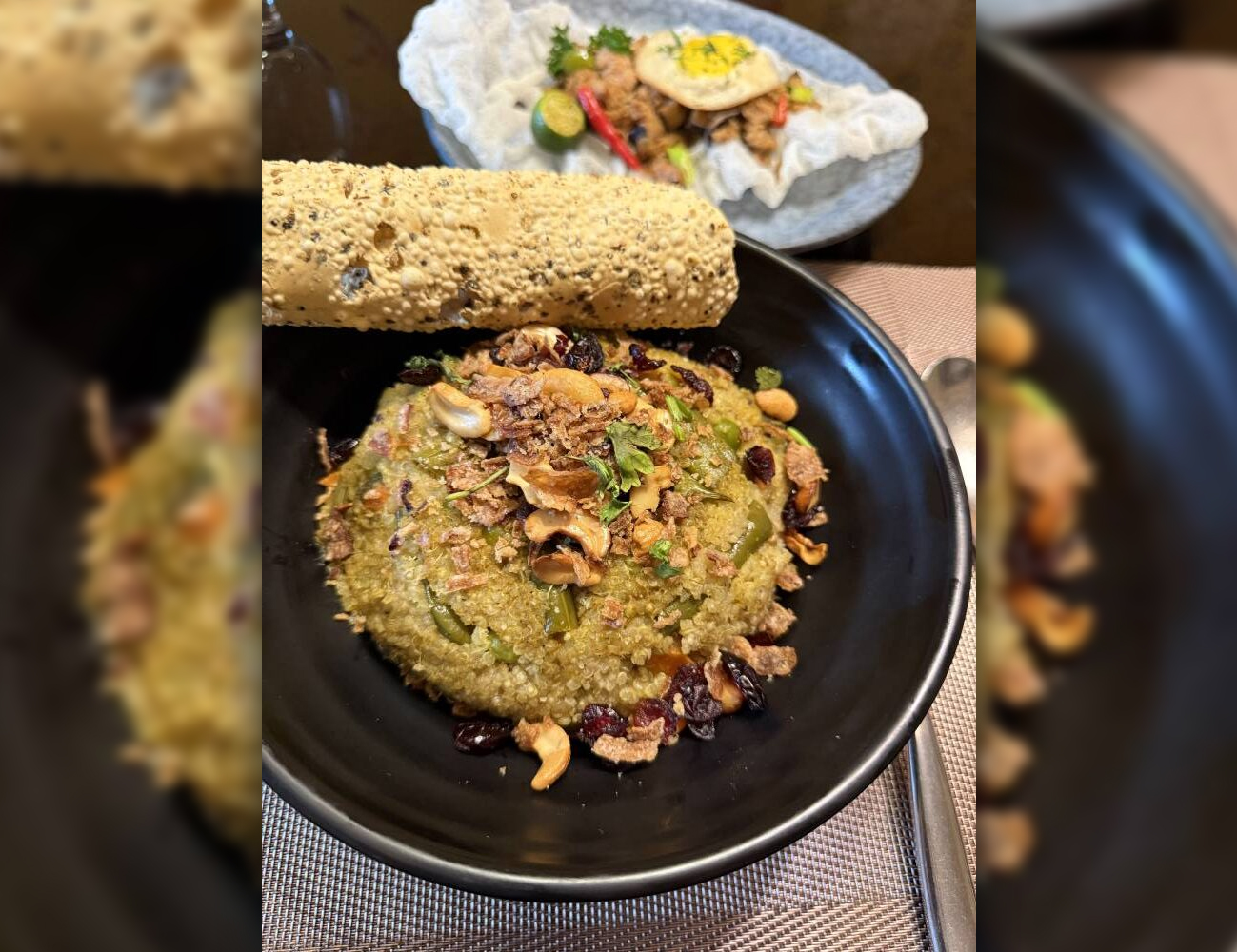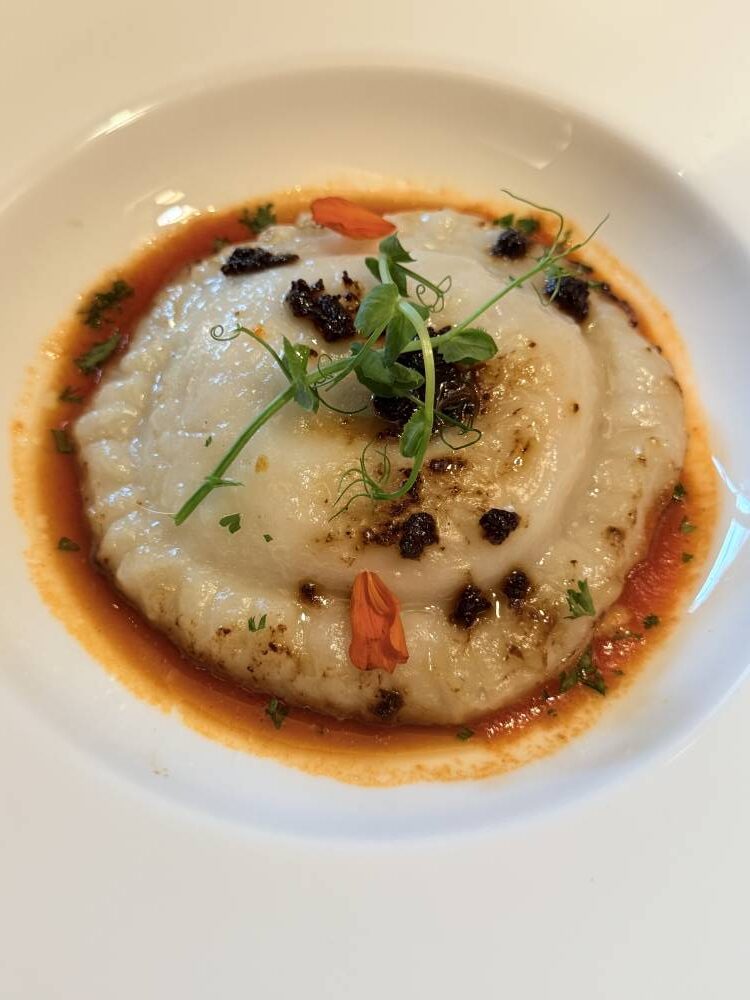Meatless has never tasted this local

Vegan sisig topped with a tofu sunny-side up egg, ravioli with kimchi, ube and taro gnocchi, and pumpkin risotto laced with plant-based bagoong are among the bold new dishes recasting plant-based cuisine with flair at Joy Nostalg Hotel & Suites.
The menu overhaul is part of a global initiative of the hotel’s new owner, The Ascott Limited, to have at least 30 percent of offerings plant-based, aligning with broader sustainability goals. Executive chef Gulshan Mohamed has taken the directive to heart, reshaping the vegetarian menu at Nostalgia Lounge & Bar not just for the environment, but also for his health.
Mohamed describes the revamped menu as Asian-inspired with distinctly Filipino touches. “From our menu analysis, we noticed that most of the dishes our guests order are Asian or Filipino,” he says. “So instead of forcing something different, we went with what the market wants and created dishes rooted in familiar Asian flavors, but with plant-based twists.”
While plant-based options still occupy a niche, Mohamed sees growing interest. “There’s definitely demand now for more vegan and vegetarian items, even if business could be better.”
For the chef, his own switch to plant-based cooking isn’t just professional—it’s deeply personal. After surviving stage one renal cell carcinoma, Mohamed began researching dietary changes to support his health. “All the research I put into this menu came from my own experience. I have to eat within certain restrictions, and that’s guided many of the choices.”

‘Lato’ and ‘ube’
The tasting begins with Watermelon Sashimi, ruby slices gently cured and plated like raw tuna, topped with pickled radish and citrus. It’s a clever play on texture—cool, crisp, and bright on the palate.
The Textures of Mushroom Salad is a medley of roasted portobello, tempura enoki, and shiitake mushrooms mixed with lato. The enoki, steamed, dehydrated, then deep-fried, offers crisp contrast to the earthiness of the portobello and the briny pop of lato. Microgreens and cherry tomatoes complete the plate. The vinaigrette, concocted with red wine, black pepper, and olive oil, ties everything together with sharp depth.
The Ube and Taro Gnocchi is a subtle homage to Filipino flavors, paired with coriander pesto and a long bean sprout salad. Mohamed uses ube, stabilized with flour and a bit of potato, to create chewy, slightly sweet dumplings, with the herbaceous pesto offering a savory balance.
Tofu Kimchi Ravioli is perhaps the boldest dish: plant-based pasta filled with spicy tofu and kimchi, served with a gochujang-based sauce brightened with apple juice, vinegar, and more kimchi. The dough, made from flour, water, and coconut milk, contains no egg. A miso-infused olive oil crowns the dish, adding umami funk.
Between dishes, we sipped a fiber-rich blend of kale, green apple, and mint—an off-menu creation by F&B manager Jay Callanga.
Pumpkin and Adlai Risotto offers a satisfying, low-carb alternative to rice. Nutty adlai (Job’s tears) stands in for arborio rice, simmered with pumpkin purée and a plant-based bagoong made from mushrooms and Korean miso—an ingredient Mohamed favors for its fish-like depth. A seared tofu “steak,” marinated in soy sauce, garlic, and olive oil, rests on top.
The Jackfruit and Chickpea Wrap is warmly spiced with Cajun seasoning and layered with bell peppers and parsley. Blanched, boiled, then roasted, the jackfruit mimics pulled meat in texture and appearance. Wrapped with chickpeas and bound by a creamy vegan mayo–tahini dressing with lemon and parsley, it comes with a lemon-dressed cucumber salad.
“The magic is in the combination—the meaty bite from the chickpeas and jackfruit, and the richness of the tahini dressing,” Mohamed says.

Bloom on the palate
Mushroom and Tofu Sisig has become the most popular dish—not just for its resemblance to pork sisig, but for its flavor and familiarity. It’s a medley of shiitake mushrooms, tofu, and Omni Crab, a soy- and mushroom-based alternative that replicates shellfish texture. Tossed in vegan mayonnaise, it’s topped with a convincing “egg” made from chickpea flour, coconut milk, tofu, and pumpkin purée. The yolk is simply roasted, thickened pumpkin.
“We cook it the same way we would any sisig,” Mohamed says, including the red chilis. “Only this one’s entirely plant-based.”
The Grilled Cauliflower Steak is hearty fare. Marinated overnight in olive oil, lemon juice, salt, pepper, and parsley, the cauliflower is grilled for char, then finished in the oven. It sits on a hummus base enriched with tahini, sumac, and lemon, with chickpea flour adding body.
Fragrant with spices and layered with vegetables, the Quinoa Biryani is the final flourish. This plant-based version of a classic dish is cooked with a gluten-free grain crop instead of rice for higher protein content.
Mohamed’s plant-based cuisine is anything but austere. His dishes are vibrant with spice, lush in texture, and plated with care—rooted in local familiarity but elevated with global technique. Indian influences shine through in his use of aromatics, but his true guide is advocacy.
“People think plant-based food is just lettuce or that it’s bland,” he says. “I want to prove it doesn’t have to be.”
That proof is in the details. Many dishes take longer to prepare than their meat-based counterparts: Jackfruit must be boiled for hours to get the meaty texture, chickpeas soaked and slowly cooked, cauliflower marinated for two days, and vegan mayonnaise made from scratch. Cut in wedges, the watermelon for the sashimi is marinated, vacuum-sealed to lock in flavor, then slow-roasted to evoke the texture of raw fish.
The complexity is intentional—a way to recreate the flavors and textures diners instinctively crave, whether fishy, minty, or meaty. With layered aromatics, coconut-based butter, and carefully fermented ingredients, Mohamed believes the effort is worth it. The flavors bloom more fully on the palate, turning plant-based cuisine into an experience of abundance rather than absence.

















